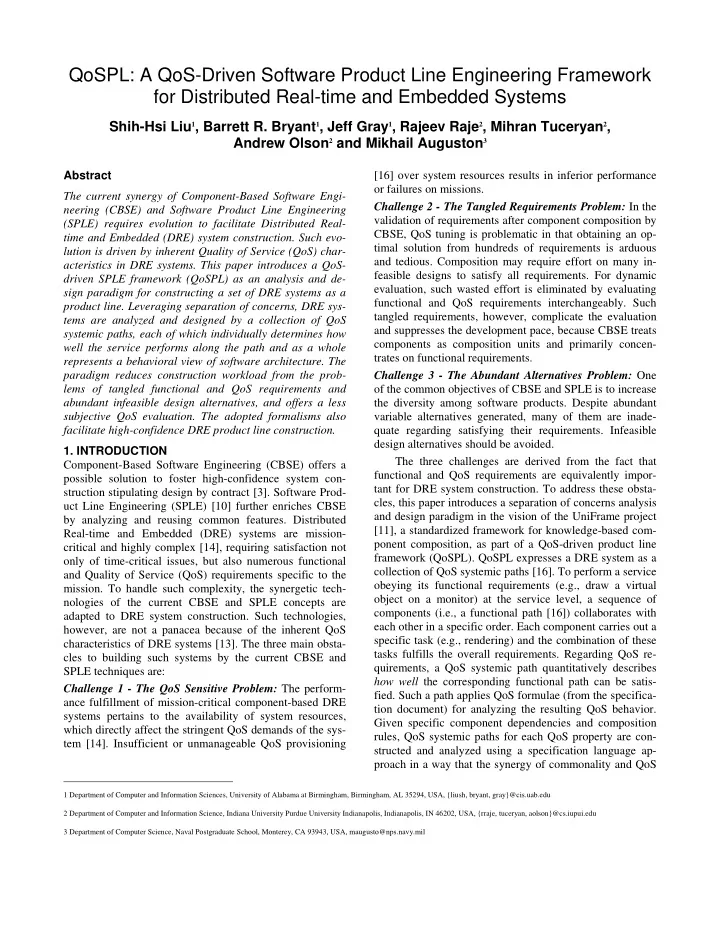

QoSPL: A QoS-Driven Software Product Line Engineering Framework for Distributed Real-time and Embedded Systems Shih-Hsi Liu 1 , Barrett R. Bryant 1 , Jeff Gray 1 , Rajeev Raje 2 , Mihran Tuceryan 2 , Andrew Olson 2 and Mikhail Auguston 3 Abstract [16] over system resources results in inferior performance or failures on missions. The current synergy of Component-Based Software Engi- Challenge 2 - The Tangled Requirements Problem: In the neering (CBSE) and Software Product Line Engineering validation of requirements after component composition by (SPLE) requires evolution to facilitate Distributed Real- CBSE, QoS tuning is problematic in that obtaining an op- time and Embedded (DRE) system construction. Such evo- timal solution from hundreds of requirements is arduous lution is driven by inherent Quality of Service (QoS) char- and tedious. Composition may require effort on many in- acteristics in DRE systems. This paper introduces a QoS- feasible designs to satisfy all requirements. For dynamic driven SPLE framework (QoSPL) as an analysis and de- evaluation, such wasted effort is eliminated by evaluating sign paradigm for constructing a set of DRE systems as a functional and QoS requirements interchangeably. Such product line. Leveraging separation of concerns, DRE sys- tangled requirements, however, complicate the evaluation tems are analyzed and designed by a collection of QoS and suppresses the development pace, because CBSE treats systemic paths, each of which individually determines how components as composition units and primarily concen- well the service performs along the path and as a whole trates on functional requirements. represents a behavioral view of software architecture. The Challenge 3 - The Abundant Alternatives Problem: One paradigm reduces construction workload from the prob- lems of tangled functional and QoS requirements and of the common objectives of CBSE and SPLE is to increase the diversity among software products. Despite abundant abundant infeasible design alternatives, and offers a less variable alternatives generated, many of them are inade- subjective QoS evaluation. The adopted formalisms also facilitate high-confidence DRE product line construction. quate regarding satisfying their requirements. Infeasible design alternatives should be avoided. 1. INTRODUCTION The three challenges are derived from the fact that Component-Based Software Engineering (CBSE) offers a functional and QoS requirements are equivalently impor- possible solution to foster high-confidence system con- tant for DRE system construction. To address these obsta- struction stipulating design by contract [3]. Software Prod- cles, this paper introduces a separation of concerns analysis uct Line Engineering (SPLE) [10] further enriches CBSE and design paradigm in the vision of the UniFrame project by analyzing and reusing common features. Distributed [11], a standardized framework for knowledge-based com- Real-time and Embedded (DRE) systems are mission- ponent composition, as part of a QoS-driven product line critical and highly complex [14], requiring satisfaction not framework (QoSPL). QoSPL expresses a DRE system as a only of time-critical issues, but also numerous functional collection of QoS systemic paths [16]. To perform a service and Quality of Service (QoS) requirements specific to the obeying its functional requirements (e.g., draw a virtual mission. To handle such complexity, the synergetic tech- object on a monitor) at the service level, a sequence of nologies of the current CBSE and SPLE concepts are components (i.e., a functional path [16]) collaborates with adapted to DRE system construction. Such technologies, each other in a specific order. Each component carries out a however, are not a panacea because of the inherent QoS specific task (e.g., rendering) and the combination of these characteristics of DRE systems [13]. The three main obsta- tasks fulfills the overall requirements. Regarding QoS re- cles to building such systems by the current CBSE and quirements, a QoS systemic path quantitatively describes SPLE techniques are: how well the corresponding functional path can be satis- Challenge 1 - The QoS Sensitive Problem: The perform- fied. Such a path applies QoS formulae (from the specifica- ance fulfillment of mission-critical component-based DRE tion document) for analyzing the resulting QoS behavior. systems pertains to the availability of system resources, Given specific component dependencies and composition which directly affect the stringent QoS demands of the sys- rules, QoS systemic paths for each QoS property are con- tem [14]. Insufficient or unmanageable QoS provisioning structed and analyzed using a specification language ap- proach in a way that the synergy of commonality and QoS 1 Department of Computer and Information Sciences, University of Alabama at Birmingham, Birmingham, AL 35294, USA, {liush, bryant, gray}@cis.uab.edu 2 Department of Computer and Information Science, Indiana University Purdue University Indianapolis, Indianapolis, IN 46202, USA, {rraje, tuceryan, aolson}@cs.iupui.edu 3 Department of Computer Science, Naval Postgraduate School, Monterey, CA 93943, USA, maugusto@nps.navy.mil
Recommend
More recommend